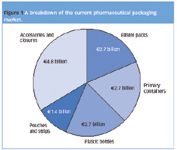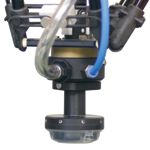20th Anniversary Special Feature: Two decades of packaging development
Pharmaceutical Technology Europe
Twenty years ago it was commonplace for pills, tablets and capsules to come in small, plastic or even glass bottles. Syrups were a much more common galenic solution than today, and individual dosages of injectables were only offered in glass vials and ampoules.
Twenty years ago it was commonplace for pills, tablets and capsules to come in small, plastic or even glass bottles. Syrups were a much more common galenic solution than today, and individual dosages of injectables were only offered in glass vials and ampoules.

While it is observable that trends vary regionally — in Europe, blister packs have all but displaced glass or plastic bottles, while in the US bottled pills remain popular — there are many global trends that have emerged during the past two decades. Where once galenics were largely confined to pills, tablets and gel capsules; syrups; injectables; and suppositories, there are now several new methods that are becoming more popular, including individually dosed powders, inhalables and pens. All of these developments, along with increasing competitive pressures and the patient's need for convenience, have influenced packaging design, styles and manufacturing.

Sigpack Systems continuously surveys pharmaceutical market leaders, mainly across the US and Europe, about the industry's requirements for packaging. It also remains abreast of legislative and regulatory trends. In this article, some of the results of recent observations are considered along with predictions about developments in the pharmaceutical sector and their implications for packaging machinery.
Constant advancement
The pharmaceutical packaging market is constantly advancing and has experienced annual growth of at least 5% per annum during the past few years with single applications showing double-digit growth. The market is now estimated to be worth more than $21 billion (€14.5 billion) a year. Figure 1, which provides a breakdown of the current packaging industry, illustrates how the variety of packages have moved inexorably toward blisters and strips, but also how much accessories and closures (indicative of convenience packaging) accounts for in the total value. Blister packs, plastic bottles and primary containers each account for $4 billion (€2.7 billion); pouches and strips account for a further $2 billion (€1.4 billion); while accessories and closures now make up one third of the packaging value at $7 billion (€4.8 billion).

Figure 1 A breakdown of the current pharmaceutical packaging market.
As with most other packaged goods, pharmaceuticals need reliable and speedy packaging solutions that combine product protection, quality, tamper evidence, patient comfort and security needs. Constant innovations in the pharmaceuticals themselves (e.g., prefilled syringes, blow-fill-seal (BFS) vials and powder applications) have also directly impacted on the packaging.
Traditionally, more than 50% of all medicines have been oral tablets or capsules, packed in blister packs (very common in Europe and Asia) or fed into plastic pharmaceutical bottles (especially in the US). Powders, pastilles and liquids also make up part of the oral medicine intake. However, other methods for taking medicines are now becoming more widely used. These include parenteral or intravenous (~29%), inhalation (~17%) and transdermal (~3%) methods. Oral tablets are now available in a wide range of shapes and sizes.

These changes have had a big impact on the packaging industry. There is also an increasing need to provide tailored, individual packaging solutions that guarantees the effectiveness of medicines. Degradation as a result of environmental factors, such as light and humidity, often indicates a direct link between packaging and a remedy's effectiveness.
The packaging of oral medicines generally conforms to requirements for easy dispensing, child resistance and senior-friendliness, but packs must also be identifiable, functional and, very often, hermetically sealed. Some innovations provide added benefits in one area, but may not conform to the expected standards governing another. For instance, blister packs provide convenience and ensure hygiene. They are ideal for our fast-paced lifestyles and the need to take medication on the go and, as a result, there has been a large increase in their use. Indeed, blister packaging has provided the best worldwide growth among all pharmaceutical packaging products. The average demand increases 6.2% annually and reached more than $4 billion (€2.7 billion) in 2006.
However, alongside increased hygiene and convenience, the medicine still has to be child resistant and identifiable. Few blister packs are child resistant, and this goes against recent government proposals to ensure that medicines containing aspirin, paracetamol and iron are supplied in child-resistant packaging to reduce the occurrence of accidental poisonings. The proposed legislation particularly targets blister packs.

The future
Advances in packaging machines
Advances in packaging machines have included incorporating precise filling mechanisms, as the wrong dosage of a medicine could be life threatening. Gentle handling is also essential and packs should be hermetically sealed for higher product safety. A solution to achieve hermetically sealed packs for blister, blow-fill-seal pouches, vials and other products is to overwrap them into a horizontal flow wrap. These flow wraps consist of a foil laminate that is able to increase the shelf life of the product, as well as ensure 100% moisture and air tightness.
Some packaging requirements are not driven by the need for hygiene, safety or traceability. The increased focus on the marketing of pharmaceutical products will become even more important in the future, and will influence factors such as the need for flexibility in various pack types and sizes. Other needs are driven by expenses as pharmaceutical manufacturers face increased cost pressures throughout the entire production and packaging process. As a result, packaging machines must become more efficient and user friendly, offering flexibility, easy operation, robustness, intelligence and protection from interference. The challenge is to be able to cover all aspects at once.
The ongoing globalization trend —with extended competitive landscape in the pharmaceutical industry — will lead to smaller batch sizes as no one company is likely to dominate the market with high-volume blockbuster drugs. Using existing packaging equipment will have a negative effect on productivity because older machines were generally not designed for quick changeovers and flexibility. New packaging lines will have to offer high flexibility while maintaining production levels.
Availability is an absolute must in the pharmaceutical industry, which necessitates the highest possible packaging speeds combined with minimal waste and high flexibility. High-speed lines can produce the requested small batch sizes within a few hours, but then resetting formats requires additional hours, which negatively impacts the overall efficiency of the packaging line. Format changes and line clearance should be performed within a few minutes. To cope with this, the whole packaging process, including all modules and machines used in the entire system, must be completely harmonized. It is of no use if the majority of machines can be changed to handle a new batch within 15 min if it then takes more than 2 h to do the line clearance because some areas suffer from poor accessibility.
Robot invasion
To accommodate quick changeover times robotic toploading solutions, which are partly replacing sideloader technology in the packaging of cartons, are increasingly being used. With smaller batch sizes — in some cases, very small batch sizes are already a reality — toploaders increase the overall efficiency of the line. When compared with sideloading, toploading significantly reduces the format change time, sometimes from 1–2 h to less than 30 min, and offers greater flexibility for use with various pack types and packing patterns.
To meet validation requirements, pharmaceutical companies increasingly demand that machinery is modularized and standardized. This includes a standardized operating interface and control systems for all components. Such systems also have monitoring systems for maximum production safety. With standardization and modularity, profitability can also be increased because the lines have to provide rapid changeover times to cater for different dosages of the same medicine in different pack types. The increased profitability is additionally supported by lower maintenance costs.
It takes more than technology and its standardization to produce high efficiencies — the entire packaging process needs to be harmonized, which offers huge optimization potential. Within the pharmaceutical production and packaging process, many operations and interfaces between process steps are still performed manually. In the future, many of these tasks will be taken over by flexible robotics technology or smart mechanical solutions. For example, the entire feeding process of products coming from batch production to the packaging line is, predominantly, still a manual process, which will be automated within the next few years. Already, many automated robotic solutions are available to handle blister packs, drug delivery devices, medical devices, intravenous bags, blow-fill-seal bottles, tubes and other products.
Contemporary trends
Until recently, pharmaceutical packaging had to fulfil three main objectives:
- protection of the product
- tamper evidence
- consumer safety.
While these criteria still apply — indeed, more than ever in some regions — there is a further dimension that has emerged: packaging ergonomics and design.
While blister packs for tablets and gel capsules remain dominant, the packaging of loose powders and liquids has undergone some radical developments that packaging systems companies have been required to address as partners to the drug manufacturers. For example, vials produced using BFS technology are gradually replacing glass-filled ampoules for dosages of injectible, ophthalmic or inhalation treatments. BFS will dominate because the process enables very high-speed, low-cost automation, greater resilience and cheaper packaging materials.
BFS vials solution
One application for BFS vials is at Dey Laboratories (CA, USA), which produced cards of five BFS vials. Single overwrapped vials were needed for hospitals, but Dey had never packaged these. The company needed an experienced packaging partner to integrate an entire high-speed line (HSL). The new packaging would also need to satisfy FDA requirements without compromising throughput.
The challenge was to separate the vials without cutting or breaking them and causing a leak. They also had to be sealed and hermetically wrapped at 600/min. This required two of our HSL wrappers, which can wrap 300 products/min.
Prefilled syringes
Sigpack has also supplied a major Japanese manufacturer of prefilled glass and plastic syringes with an automatic flow wrapping system. Starting at a discharge unit from a buffering system, we had to integrate this with the flow wrapping process and an optional oxygen absorber supply. A high sophisticated product handling solution was also needed.
A rotary disk feeder, combined with a linear screw feeding unit, was selected. As a special packaging option, the sealing of customized Tyvek (Du Pont, DE, USA) material was also used for complete sterilization procedures after the flow wrapping process.
The integrated flow wrapping system produces up to 250 packages/min, while retaining compliance with the strict quality standards demanded by the Japanese market. The horizontal form fill-seal-technology enables higher productivity, shorter change over times for existing formats and a significant reduction in material costs.
New stick pack format
However, it's not just packaging demands that lead to innovation. Sometimes the packaging itself aids a product's commercial success. For example, the stick pack, which has been popular for years for sugar and beverage packaging, provides a high-speed and inexpensive method of packaging accurately measured doses of pharmaceuticals. This simple style of packaging is growing quickly within certain sectors, such as digestive remedies. Growth was 30% during 2007.
Pack style
Working with Warner-Chilcott (NJ, USA) to design packaging for birth control pills, we developed a customized blister packaging system to handle the new pack style. With a production speed in excess of 170 packs/min, contraceptive pill blisters are hermetically sealed using an aluminium foil. The flow-wrapped package includes the plastic wallet to hold the blister envelope, a desiccant and a folded patient information leaflet.
The HBL is a long dwell seal machine that produces pillow-type packaging with hermatic sealing, and includes reciprocating cross sealing jaws to guarantee perfect airtight seams, which this makes it highly practical for pharmaceutical blisters and hygroscopic products.
Warner-Chilcott now has a holistic system solution that manages the blister, wallet holder, patient information and desiccant with highest production efficiencies.
Conclusion
Most markets evolve, but few have seen the radical shifts that have occurred in the pharmaceutical sector. There is no sign of this abating during the coming years because legislative, as well as commercial and galenic, developments create a continuous need to match change with similar packaging transformation.
Andreas Graf is head of industry management for pharma, medical and healthcare business at Bosch Sigpack Systems AG (Switzerland). During Sigpack's 2004 merger with Bosch, he was product manager for flow wrapping systems. Originally trained as an engineer, Andreas has worked within the pharmaceutical industry in a variety of roles for more than 10 years. He is currently studying at Zurich's Graduate School of Business Administration in Switzerland on a global MBA programme in partnership with the Robert H. Smith School of Business (MD, USA).

Drug Solutions Podcast: A Closer Look at mRNA in Oncology and Vaccines
April 30th 2024In this episode fo the Drug Solutions Podcast, etherna’s vice-president of Technology and Innovation, Stefaan De Koker, discusses the merits and challenges of using mRNA as the foundation for therapeutics in oncology as well as for vaccines.
Pharmaceutical Tariffs Are Imminent: How Industry is Bracing for Impact
April 16th 2025On April 14, 2025, the Trump Administration launched a national security-driven investigation into pharmaceuticals, a move that will likely result in tariffs being placed on pharmaceutical drugs, ingredients, and other components that are imported from outside of the United States.